A Superconducting Model
of the Sun
There are two popular and competing models that describe how the Sun
works. As in, how it glows, gives off heat, light, solar
wind, etc.
The most well-known of these is the thermonuclear model.
In this model, loose accumulations of interstellar hydrogen are drawn
together under the pull of their own gravity and into a sphere of
compressing gas. The process involves friction, which causes
the gas to glow either red or infrared, and leads to what we call a
brown dwarf.
If this process were allowed to continue, and with increasingly larger
amounts of hydrogen involved, the pressure at the interior of the ball
would become so high that the hydrogen would undergo nuclear fusion:
first into helium, and then into higher order elements. The
energy released by this fusion process would cause the gaseous ball to
glow white-hot, leading to a star like our Sun.
In the thermonuclear model the Sun’s interior is millions of degrees
Celsius. This steadily decreases toward the surface where we
observe a temperature of around five thousand degrees.
A lesser-known explanation is the electric model.
In this model, the glow we observe from the Sun’s surface is not caused
by fusion but by electrical discharges; similar to the electric
arcs/sparks seen on a welding device. For this to happen the
Sun must have a strong net-positive charge. It is made out of
plasma (ionised gas) and this positive plasma steadily discharges at
its surface. Its interior is a few thousand degrees
throughout; slightly cooler than the photosphere surface. And
its interior charge counteracts gravity to prevent further collapse.
(The above is a very brief introduction and admittedly the subject
takes some getting used to. For a better description of the
Electric Sun model see
http://www.electric-cosmos.org/sun.html
)
Of these two models, the more likely is the electrical one.
It correctly accounts for the magnetic fields, the appearance of tufts,
its temperature increase whilst heading outward toward the corona, the
solar wind, and occasional flaring.
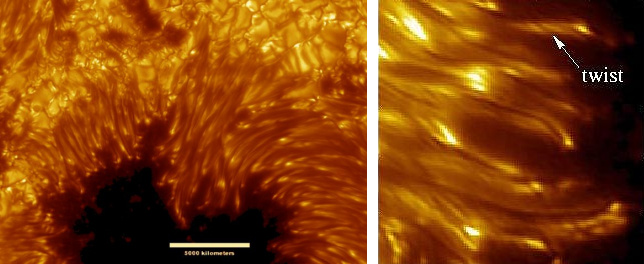
In these close-ups of sunspots we see
twisted glowing strands. These are consistent with Birkeland currents,
a type of electrical arcing seen in plasma discharges.
Credit: SST, Royal Swedish Acadmey of Sciences

Here we see coronial plasma loops, an
effect related to magnetism. The Sun’s magnetic field can
also be detected far out into the solar system.
Credit: M. Aschwanden et al. (LMSAL), TRACE, NASA

This diagram shows the Sun as a large positively
charged ball and the voltage potential arising from it. The
high positive charge causes a discharge of protons into the
photospheric gasses, leading to plasma glowing effects. The
protons then continue to accelerate and strike the corona (an outer
layer of gas surrounding the Sun) at high speed, leading to even higher
temperatures there.
Credit: The Electric Universe, Thornhill & Talbott
Where’s the power?
Despite its success though, the electric Sun model does appear to
suffer a major deficiency. Namely the question: what powers
this electrical giant? Specifically, what gives it a positive
charge, and what drives the currents necessary to explain its magnetic
fields?
According to the theory, the Sun is powered by streams of electrons
funnelling inward toward the polar regions. These ‘galactic
powerlines’ interconnect all the stars in the galaxy and feed them the
necessary current to power their photospheres. The presence
of these has been partially observed via the Ulysses craft, which
passed over the polar regions [1].
But while there could be little disagreement that a positively-charged
ball would attract electrons, there are major problems in suggesting
that this could be its power source.
First, a stream of electrons ‘falling’ into the Sun is not going to do
much other than steadily discharge it. In order to power an
electrical device (e.g. a desk lamp), charge must be forcefully fed
into it and then extracted again. This is because the device
has resistance that needs to be overcome. But the electrical
Sun model describes a one-way inward current flow. And it’s
not forced, just free-falling.
Second, since the Sun is emitting positive charges, the net current
supply must consist of protons rather than electrons otherwise the
output current the solar wind would eventually
cease. This is a big problem because protons won’t
move toward a net-positive charge unless they are somehow forced or
initially fired (from where?) at high speeds. But the model
allows for no such inward positive flow and no observations support it.
So what then could explain the power supply and nature of the Sun?
What if
?
What if, instead of the high-temperature thermonuclear model, we said
the Sun steadily grew cooler as we headed inwards? And by
‘cooler’, I don’t just mean in a sense relative to its surface, as in a
few thousand degrees. Nor even a few hundred
degrees. And not even a few degrees below room temperature,
but colder again.
What if the temperatures in the Sun’s interior became so cold that they
approached levels nearing absolute zero Kelvin the lowest temperature
possible for any material?
The idea sounds absurd! It is the complete opposite of the
conventional model, with its millions-of-degrees thermonuclear
core. And after all, how could a compressed gas become cold?
Extreme compression of a gas
To understand how this might be possible, consider an airtight cylinder
with a piston at one end. We fill the cylinder with nitrogen
(which is basically air minus oxygen) and begin to apply pressure to
the piston. What will happen?
This is somewhat like compressing air inside a bicycle pump.
The pressure will increase and the temperature will rise.
After a while though, this heat from the compression process will
dissipate and the temperature will return to the surrounding air
temperature.
So we push the piston further. Once again, the nitrogen
pressure will increase and the temperature will temporarily rise before
returning to normal.
Now let’s suppose our cylinder was very strong and we were able to
apply a very high amount of force to the piston. In this case
the gas will compress so much that it will cease being a gas and become
a liquid: liquid nitrogen.
Take this idea further. We continue to apply ever larger
forces on the piston. Eventually this liquid will be forced
to collapse into ‘solid nitrogen’.
As is well known, liquid and solid nitrogen are very cold
substances. However it needs to be quickly pointed out
that we have not made anything cold. Rather, the liquid and
solid states of nitrogen will at first be at high temperature and
pressure. After a while, the heat will dissipate and
temperature will return to the surrounding air temperature.
But compared to regular (cold) liquid or solid nitrogen, the pressure
is very high and the substance would explode into gas if released.
Compression under gravity
Now consider a similar situation for a star. Under the
standard astronomy model, stars are formed when loose accumulations of
hydrogen gas are drawn together under the force of their own
gravity. As this occurs, gas is compressed and heats up,
giving out infrared heat. This increase in temperature might
halt the compression process for a time. But adding more gas
will force the compression to continue.
Eventually the internal gaseous resistance will give way, allowing the
hydrogen to liquefy. Although this liquid will be still be
quite hot. We continue to add more hydrogen, increasing the
external pressure. Eventually this liquid also gives way, and
the hydrogen collapses into a solid.
At this stage the solid is somewhat disorganised, its atoms not
arranged according to any particular pattern. We continue to
increase pressure. Eventually the hydrogen atoms are forced
into crystalline lattice structures. We could now refer to
this as ‘metallic hydrogen’.
The atoms have now become rather restricted in their
movement. They are unable to move about freely as they did in
their gas, liquid or semi-solid state. Instead they are
restricted into vibrating along short distances.
Despite the restriction in distance though, this rapid movement still
accounts for a high temperature; since that vibration is essentially
the definition of temperature. But if enough pressure were
applied to the lattice, the hydrogen atoms would be almost unable to
move. They would effectively have become frozen and could
thus be described as having a temperature of near absolute zero.
So
what happens when we freeze a metal or crystalline material to near
absolute zero? The title of this essay gives it away: it
becomes superconducting!
As is known, superconductors allow electrons to flow through them
without resistance. A superconductor formed into a ring or
disk can maintain an internal electric current that circles
forever. And as it does so, it emits a magnetic field, just
as an electromagnetic coil would do. Except a superconductor
magnet requires no power supply to maintain it.
Therefore a superconductor formed into a ball should also be able to
maintain internal currents that cycled forever and without the need for
any power supply.
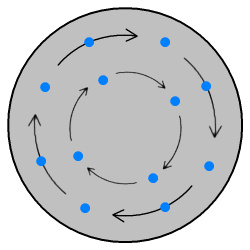
Electrons circling within a superconducting ball or disk.
Current cross-section of a wire
So what does this mean? Quite obviously, if the Sun were a
giant superconductor, we should likewise expect it to contain powerful
circling currents. These currents would then generate large
magnetic fields. And we certainly do observe magnetic fields
and related effects like plasma loops coming from the Sun (see eariler
diagram).
But there is more to this story than just magnetism.
Consider now two parallel wires, each carrying a current in the same
direction. We know from observation that these will attract
each other.

Magnetic attraction from parallel currents.
Now consider the situation inside just a single current-carrying
wire. We will give this wire a rectangular cross section,
with width is twice its depth. Below is an enlarged top and
cross-section view.
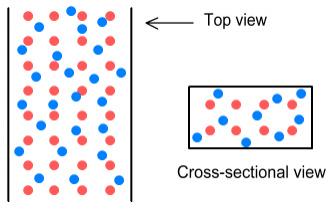
Electrons stationary inside a wire with rectangular
cross-section.
Here we see the wire with protons and electrons both stationary, i.e.
no current is flowing yet. If we draw an imaginary dividing
line down the middle of the wire we notice that it would become
analogous to the two parallel current-carrying wires described earlier,
except without a gap between them. Therefore, like the
two-wire situation, we should expect flowing electron streams to
attract each other like so:
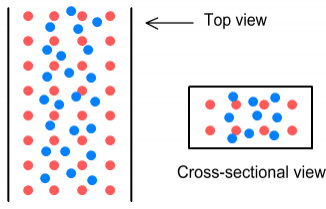
Electrons flowing inside a wire with rectangular
cross-section.
Here we see an electron current flowing and the electrons are now
concentrated along the middle of the wire. This gives the
inner part of the wire a slight negative charge. Meanwhile
the outer edges of the wire have a lack of electrons and therefore
gain a slight positive charge.
Does this happen in reality? It doesn’t.
Experiments show that current density remains uniform when DC currents
are involved. And when an AC current is fed through, the
electrons push themselves against the walls of a wire. This
is called the ‘skin effect’.
Given our knowledge of magnetism however, this appears
curious. Because by all accounts the electrons should
accumulate into the middle portion of the wire in both the DC and AC
scenarios.
It appears something else is going on inside wires, namely ‘eddy
currents’. These are tiny ‘whirlpool’ currents that appear to
develop inside conductors, repelling attractive current flow and
pushing the electrons to the outside. In the AC case the
effect is more pronounced.
But we are not dealing with regular conductors. We are
dealing with superconductors, and these have rather different
properties where magnetism is concerned. Given that
superconductors have zero resistance, perhaps eddy currents don’t
develop or are too minor to be a problem. Therefore for
superconducting wire, especially where large currents are concerned,
magnetic forces may well focus the electrons along the middle of the
wire, as indicated above.
Next consider the situation for a superconducting disk. We’ll
start by having electrons circle around its centre.

Electrons circling in disk (no magnetic attraction).
Since these electrons are moving in parallel, we should expect them to
magnetically attract each other, resulting in a situation like this:
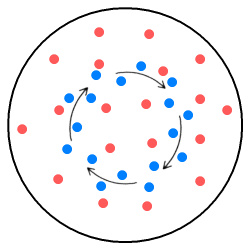
Electrons circling in disk, with internal magnetic
attraction.
As with the rectangular wire above, the electrons have concentrated
themselves into a negatively charged ring-shaped region located between
the centre and the perimeter. The reason for a ring and not a
small inner disk is that the electrons moving in opposite directions on
either side of the ‘inner disk’ will magnetically repel each
other. The result will be a negatively charged ring with a
positively charged regions either side: one in the centre and the other
along the outer part of the disk, as shown below.
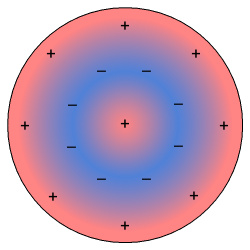
(Fig 10) Magnetic attraction and repulsion of circling electrons
leaves positive and negative regions within a disk.
Now extend the above situation to a ball-shaped
superconductor. Particularly one the size of the
Sun. We should expect large internal currents, which focus
themselves into a middle negative region, whilst leaving a positive
region in the centre and on the outside.
This outer positive region is of particular interest. If the
charge were strong enough, we should expect electrical discharges to
occur across the surface of the Sun, as protons leapt off the
surface.
If the surface were covered by a gaseous layer (and it is with the
Sun) the motion of protons passing through it would cause the surface
to light up with electrical sparks, also known as ‘anode
tufts’. We should also expect a steady discharge of protons
accelerating out as a solar wind. And if for some reason the
sparking stopped at some area, causing sunspots, we should also expect
those regions to be darker because we would now be looking at the
relatively cooler solid surface of the Sun. And sure enough,
this all corresponds to what we see!
Since currents can circle forever within a superconductor, the above
describes a model in which a star can glow indefinitely, without any
external power source or requirement for internal fusion.
Electrons will still be attracted and flow inward toward the Sun’s
positive surface. However, these are not required for the Sun
to glow and act more as a power discharge than a power supply.
What about density?
In order for this model to be viable it needs to show an agreeable
density. The density of the Sun is 1400kg/m3 or 1.4 times
that of water. This is of course an average. We
should expect the density to be less near the surface and steadily
increase toward a value higher at the centre.
So how does the 1400 number fit with this model?
Below is a table showing the densities of various substances in
ascending order and compared with the Sun’s average.
| Substance |
Density (kg/m3) |
| Hydrogen gas |
0.09 |
| Helium gas |
0.18 |
| Helium solid |
0.21 |
| Nitrogen gas |
1.3 |
| Tungsten Hexafluoride gas |
13 |
| Hydrogen liquid |
71 |
| Helium liquid |
125 |
| Lithium solid |
534 |
| Hydrogen solid |
600 |
| Nitrogen liquid |
807 |
| Water liquid |
1000 |
| Nitrogen solid |
1030 |
| Sun (average) |
1400 |
| Quartz (SiO2 typical rock) |
2600 |
| Diamond (carbon) |
3500 |
| Iron |
7900 |
| Lead |
11000 |
Note the position of hydrogen gas on the list. At 0.09
kg/m3, it is far less than the 1400 required. Likewise with
heavier gasses such as helium and nitrogen. In fact even the
densest gas known, tungsten hexafluoride, falls well short of what is
required. This would appear to rule out an interior of a
gaseous or plasma nature.
Hydrogen in its liquid state is still too light, as is
helium. Liquids made of heavier elements would certainly
work, although that requires them to be far above hydrogen on the
periodic table, and which requires going back to the problematic fusion
model.
Going to typical solids, such as diamond (compressed carbon) places us
too high on the list. Carbon is said to be a common fusion by-product in
the thermonuclear model.
But solid hydrogen appears nearer the mark.
Solid hydrogen has a density of 600kg/m3. The 1400
Sun-density value seems to correspond to hydrogen compressed to a bit
over double that amount. If we estimate a higher density for
the Sun’s interior of 1800kg/m3, that makes it 3 times the 600
hydrogen figure. Admittedly the 1800 number is a guess and
the real density might be higher; although could not be too much higher
because the 1400 average would be wrong.
Thus, a Sun comprised of compressed solidified hydrogen would have a
density consistent with what we observe, and is supportive of the model
described here.
Of course it would also be possible to achieve the 1400 average using a
combination of elements. Metallic lithium for example has a
density of 534kg/m3. So compressing that several times can
give the necessary density. Or combining it with heavier
elements like iron would also work. However, it will require
fusion and also require the relative abundance of such substances be
very different than what is observed in the universe. Thus
metallic hydrogen still seems the more likely candidate [2].
Solar Oblateness and Rotation
Here’s another point to consider. As we know, the Sun rotates
on its axis, and this rotation gives rise to a bulge around its
equator, similar to the way the Earth bulges around its equator.
The degree of bulge called the solar oblateness however, is far
smaller than what would be expected for a flexible rotating ball of
that size, mass and angular speed. In fact the Sun comes
close to being a perfect sphere.
But if the interior of the Sun were not made of gas or plasma, and was
instead a solid ball, the above observations on oblateness would make
sense. Because only the outer flexible layer of the
photosphere gasses would be able to bulge and the amount of bulge would
be limited by its thickness.
And speaking of rotation, another interesting fact is that the Sun
rotates faster at its equator than at its poles. This tells
us that some of the observed rotation may just be a surface effect and
leads to the possibility that the interior may be rotating even slower
again. In fact for all we know, the interior may not rotate
at all and the surface rotation we observe may be caused by interior
electrical currents pushing the photosphere around. If this
were the case it would explain why the interior solid region formed as
a sphere rather than an ‘ellipsoid’.
The overall current flow
Let’s now look at the overall current flow. The above diagram (Fig 10)
showing positive and negative regions within a disk won’t work for a
sphere. Namely, it won’t be possible for currents to circle a
sphere in all directions because electrons moving head-on would
magnetically repel. Therefore, it will instead be necessary
for currents to largely flow in the same direction.
In the previous section it was speculated that the Sun’s apparent
rotation only represented the flow of its photosphere, and that this was
being caused by the electron currents flowing in the solid interior.
This does seem likely. Since the gasses within the
photosphere are ionized into a plasma, the protons within the plasma
would be magnetically attracted to the circling electrons and
dragged across the solid surface underneath. Meanwhile the
electrons in the photosphere will move along with the protons, giving
an overall movement of the photosphere surface.
This motion of the photosphere suggests an interior current flow in
layers, i.e. many current loops running parallel to the Sun’s
equator. The overall current flow and resulting charged
regions will then look something like this:

(Fig 11) Electron currents cycle eastwards along the equator and in
many layers parallel to it. This leaves positive and negative
regions within. Arrows represent direction of electron flow
and the vertical grey line is an axis of rotation.
As with the disk, this results in positive and negative regions
within. What happens at the polar regions is uncertain since
we won’t be able to fit in a ‘mini disk’ there. So here they
are speculatively shown as having the adjacent positive regions spill over
onto them. As a result we end up with a sphere covered
by an outer positive layer.
Magnetic repulsion of the surface
Next we’ll look at the interaction between the moving photosphere and
stationary interior.
In this model, protons within the solid interior remain stationary
while the electrons cycle west-to-east, and the photosphere moves in
the same direction, albeit more slowly.
Since the protons in the photosphere are moving against those in the
interior, they will magnetically repel and be pushed away.
Meanwhile the electrons in the photosphere will be magnetically
attracted. This diagram shows the resulting force directions.
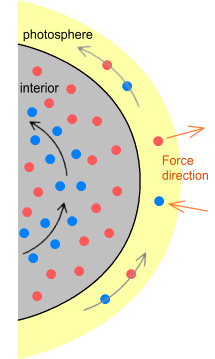
(Fig 12) Magnetic attraction/repulsion between photosphere
and interior (top view, looking down on north pole).
Protons experience repulsion and electrons
attraction as they both move over the net-positive surface of the
interior.
This interaction turns out to be very important. We know from
Coulomb’s law that a sphere containing equal amounts of positive and
negative charge can have zero net-attraction. This will be
the case when the charge is distributed with radial symmetry, i.e. if
the charge is arranged into positive and negative spherical
shells. The charge distribution diagram above (Fig 11) shows
something close to this situation.
But if differently charged regions of the interior and exterior regions
were moving against each other (as indicated in Fig 12), this can lead to
a net repulsion of the photosphere’s protons, resulting in a
glow-discharge and solar winds.
In fact without the photosphere’s rotation, it might be that the Sun
wouldn’t glow at all. It might also be true that sunspots are
caused by a slowing down of photosphere motion (for unknown reasons),
and hence a halting of the discharge process at those places.
No miniature stars
The electric star model discussed at the opening of this essay is part
of a broader body of knowledge and theory known as the Electric
Universe (EU) model. One of the big benefits of the EU model
is that it is able to recreate observed astronomical phenomena in a
laboratory. For example it is possible to produce phenomena
that look strikingly similar to nebulae formations inside plasma focus
devices.
The fact that we can do this is very impressive and tells us EU theory
must be on the right track in much of what it describes.
Despite this validity however, no similar success has been achieved in
creating a small-scale star in a laboratory. The same is true
throughout the universe: no miniature stars are seen floating about our
galaxy or elsewhere. It appears that white stars must be of a
minimum size or they won’t function.
This should be a big clue that there is more than just electricity at
play in creating a star. Namely, that a large amount of
gravity is required in order for a star to advance beyond the brown
dwarf stage and become a white star. This point further
supports the compressed superconducting model.
How long can it last?
Can the Sun/star model described here radiate forever? On the
face of it it would appear so. Superconductors can maintain a
current continuously without decrease. Therefore it would
seem that stars could output an unlimited supply of energy.
Problem is, our Sun also outputs solar wind and flares amounting to a
million tons of matter every second and consisting mainly of
protons. This process clearly can’t continue
forever. At some point it must come to a stop when the Sun
runs out of ejectable protons or becomes too negatively charged (as a
result of losing protons) and is unable to eject more. At
this point the electrical discharges in the photosphere would cease and
the Sun would become dark.
Another consideration is the inflow of electrons. As
discussed earlier, a positive charged surface would be expected to
attract a steady stream of electrons. Initially these
electrons might add to the those already circling within the
interior. This would increase the current flows, the magnetic
fields, and the brightness/intensity of the solar output.
Eventually though, the increase in negative charge would be enough to
halt the output of protons, again leading to the Sun’s demise.
Fusion
Something also needs to be said about the conversion of hydrogen into
heavier elements, i.e. fusion. The electric star model
forbids fusion within the Sun’s interior but allows for it to take
place within the electrical discharge area of the photosphere.
In this superconductor model we’ll allow that the same should
apply. Namely that there should be no fusion activity within
the frozen interior but that fusion will take place either in the
photosphere or just beneath it. How long this can continue
for is unknown. But of course, it can’t continue forever and
ultimately the conversion of too much hydrogen would bring a halt to
the radiation process; unless the conversion products were also
superconductive.
Benefits of this model
In summary then, this superconducting model neatly accounts for a
number of observations about the Sun:
- Its average density
- Its magnetic fields
- Its (seemingly unlimited) power supply
- Its minimum size
- The solar wind
- The darkness of sunspots
Conclusion
It’s possible that our Sun (and many stars) consists primarily of
hydrogen that is first compressed into a solid, then further compressed
to the point where the atoms are almost unable to vibrate. At
this point the solid becomes ‘frozen’ at near-zero absolute
temperature. This allows the substance to become
superconducting and large electrical currents to circle within it.
These currents produce magnetic fields and focus themselves into a
mid-region within the Sun, leaving a net positive area near its
surface. This positive area then electrically discharges into
the surface atmosphere, producing light, heat, solar wind, and
occasional flares.
-----------------
[1] Although the evidence is sketchy because the
craft was not designed to measure that. http://www.thunderbolts.info/tpod/2010/arch10/100204ulysses.htm
[2] Astronomers speculate that the interior of
Jupiter and Saturn consists of metallic hydrogen. Assuming their
calculations are correct, if metallic hydrogen can form within a
gas-ball the size of Jupiter, there should be no problem in it doing
likewise within the Sun.
|











